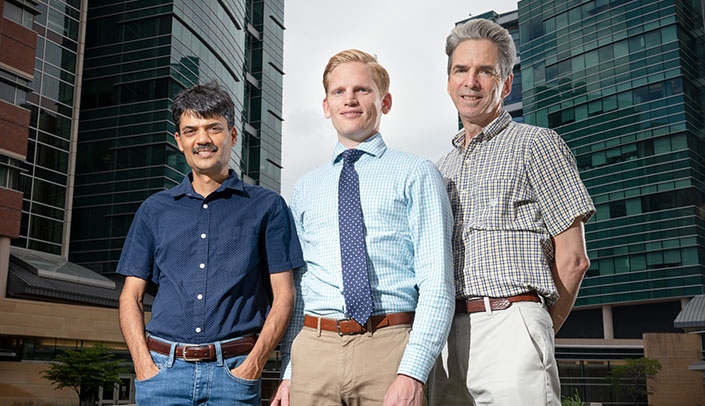A UNMC research team has used special knockout mice to determine the importance of the calcium sensor protein in initiating the eyesight process. The research appears in the June 7 issue of eLife, a high-impact journal that helps scientists accelerate research communication and discovery through its innovative open-source tool.
The role of the calcium sensor protein, known as synaptotagmin (Syt1), in interacting with rod and cone photoreceptor cells in the retina has been a long-standing question in what occurs in the beginning process of vision.
In the research study, Syt1 was selectively eliminated from specific cell types in mice by using a breakthrough technology in genome engineering known as Easi-CRISPR developed at UNMC. As the acronym implies, this technique allows scientists to custom-engineer important animal research models much more rapidly and at a significantly lower cost.
Syt1 is critical to many nerve cells and so eliminating it from the body causes mice to die within 48 hours after birth, before the retina is fully formed. To study this essential protein, the research team — headed by Wallace Thoreson, Ph.D., the Gilmore Professor of Ophthalmology and Visual Sciences and director of research for the Stanley M. Truhlsen Eye Institute at UNMC — selectively deleted Syt1 from rod and cone photoreceptor cells in the retina of the eye.
"We knew that the calcium sensor used by rods and cones of amphibians has some unusual properties," Dr. Thoreson said, "and so we were surprised that Syt1 plays such a key role in mice. We proved that — without Syt1 — the mice couldn't transmit the signals to the brain that begin the vision process."
Dr. Thoreson said the research highlights how important Syt1 is to the overall health of the whole body and ultimately could help scientists conducting research on a variety of eye and brain diseases in the future. He noted that while mutations to Syt1 are often lethal, Syt1 also has been linked to neurological deficits.
"If you want to fix the broken clock, it's important to know how the clock runs in the first place," said Dr. Thoreson, who was senior author on the paper. "We now have a much better understanding of how important Syt1 is to brain and retinal function. This is critical information that will benefit researchers worldwide."

Congratulations!
Exciting information that is extremely valuable. Congratulations Dr. Thoreson, Dr. Gurumurthy, and Dr. Grassmeyer. This shows how important support of basic scientific research can be.
Congratulations!
Breakthrough research helping to make this world healthier and better.
Thanks for your diligent work and perseverance.